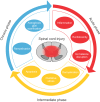Spinal Cord Injury and Related Clinical Trials
- PMID: 28261421
- PMCID: PMC5334017
- DOI: 10.4055/cios.2017.9.1.1
Spinal Cord Injury and Related Clinical Trials
Abstract
Spinal cord injury (SCI) has been considered an incurable condition and it often causes devastating sequelae. In terms of the pathophysiology of SCI, reducing secondary damage is the key to its treatment. Various researches and clinical trials have been performed, and some of them showed promising results; however, there is still no gold standard treatment with sufficient evidence. Two therapeutic concepts for SCI are neuroprotective and neuroregenerative strategies. The neuroprotective strategy modulates the pathomechanism of SCI. The purpose of neuroprotective treatment is to minimize secondary damage following direct injury. The aim of neuroregenerative treatment is to enhance the endogenous regeneration process and to alter the intrinsic barrier. With advancement in biotechnology, cell therapy using cell transplantation is currently under investigation. This review discusses the pathophysiology of SCI and introduces the therapeutic candidates that have been developed so far.
Keywords: Neuroprotective; Neuroregenerative; Pathophysiology; Spinal cord injuries.
Conflict of interest statement
CONFLICT OF INTEREST: No potential conflict of interest relevant to this article was reported.
Figures


Similar articles
-
Concise Review: Bridging the Gap: Novel Neuroregenerative and Neuroprotective Strategies in Spinal Cord Injury.Stem Cells Transl Med. 2016 Jul;5(7):914-24. doi: 10.5966/sctm.2015-0381. Epub 2016 Apr 29. Stem Cells Transl Med. 2016. PMID: 27130222 Free PMC article. Review.
-
A review of emerging neuroprotective and neuroregenerative therapies in traumatic spinal cord injury.Curr Opin Pharmacol. 2021 Oct;60:331-340. doi: 10.1016/j.coph.2021.08.009. Epub 2021 Sep 11. Curr Opin Pharmacol. 2021. PMID: 34520943 Review.
-
Thermosensitive heparin-poloxamer hydrogels enhance the effects of GDNF on neuronal circuit remodeling and neuroprotection after spinal cord injury.J Biomed Mater Res A. 2017 Oct;105(10):2816-2829. doi: 10.1002/jbm.a.36134. Epub 2017 Jul 14. J Biomed Mater Res A. 2017. PMID: 28593744
-
Traumatic Spinal Cord Injury-Repair and Regeneration.Neurosurgery. 2017 Mar 1;80(3S):S9-S22. doi: 10.1093/neuros/nyw080. Neurosurgery. 2017. PMID: 28350947 Review.
-
Promoting axonal myelination for improving neurological recovery in spinal cord injury.J Neurotrauma. 2009 Oct;26(10):1847-56. doi: 10.1089/neu.2008.0551. J Neurotrauma. 2009. PMID: 19785544 Review.
Cited by
-
Enhanced axon outgrowth of spinal motor neurons in co-culturing with dorsal root ganglions antagonizes the growth inhibitory environment.Regen Ther. 2023 Dec 10;25:68-76. doi: 10.1016/j.reth.2023.11.013. eCollection 2024 Mar. Regen Ther. 2023. PMID: 38148872 Free PMC article.
-
Protective Effects of MiR-129-5p on Acute Spinal Cord Injury Rats.Med Sci Monit. 2019 Nov 4;25:8281-8288. doi: 10.12659/MSM.916731. Med Sci Monit. 2019. PMID: 31680116 Free PMC article.
-
Ultrasound stimulation improves inflammatory resolution, neuroprotection, and functional recovery after spinal cord injury.Sci Rep. 2022 Mar 7;12(1):3636. doi: 10.1038/s41598-022-07114-6. Sci Rep. 2022. PMID: 35256617 Free PMC article.
-
Combined treatment of high-intensity interval training with neural stem cell generation on contusive model of spinal cord injury in rats.Brain Behav. 2023 Jul;13(7):e3043. doi: 10.1002/brb3.3043. Epub 2023 May 11. Brain Behav. 2023. PMID: 37165750 Free PMC article.
-
Bioinformatic Analysis of the Proteome in Exosomes Derived From Plasma: Exosomes Involved in Cholesterol Metabolism Process of Patients With Spinal Cord Injury in the Acute Phase.Front Neuroinform. 2021 Jul 9;15:662967. doi: 10.3389/fninf.2021.662967. eCollection 2021. Front Neuroinform. 2021. PMID: 34305563 Free PMC article.
References
-
- Sekhon LH, Fehlings MG. Epidemiology, demographics, and pathophysiology of acute spinal cord injury. Spine (Phila Pa 1976) 2001;26(24 Suppl):S2–S12. - PubMed
-
- Ho CH, Wuermser LA, Priebe MM, Chiodo AE, Scelza WM, Kirshblum SC. Spinal cord injury medicine: 1. epidemiology and classification. Arch Phys Med Rehabil. 2007;88(3 Suppl 1):S49–S54. - PubMed
-
- Vialle R, Levassor N, Rillardon L, Templier A, Skalli W, Guigui P. Radiographic analysis of the sagittal alignment and balance of the spine in asymptomatic subjects. J Bone Joint Surg Am. 2005;87(2):260–267. - PubMed
-
- Barron KD, Hirano A, Araki S, Terry RD. Experiences with metastatic neoplasms involving the spinal cord. Neurology. 1959;9(2):91–106. - PubMed
-
- Gerszten PC, Welch WC. Current surgical management of metastatic spinal disease. Oncology (Williston Park) 2000;14(7):1013–1024. - PubMed
Publication types
MeSH terms
Substances
LinkOut - more resources
Full Text Sources
Other Literature Sources
Medical

